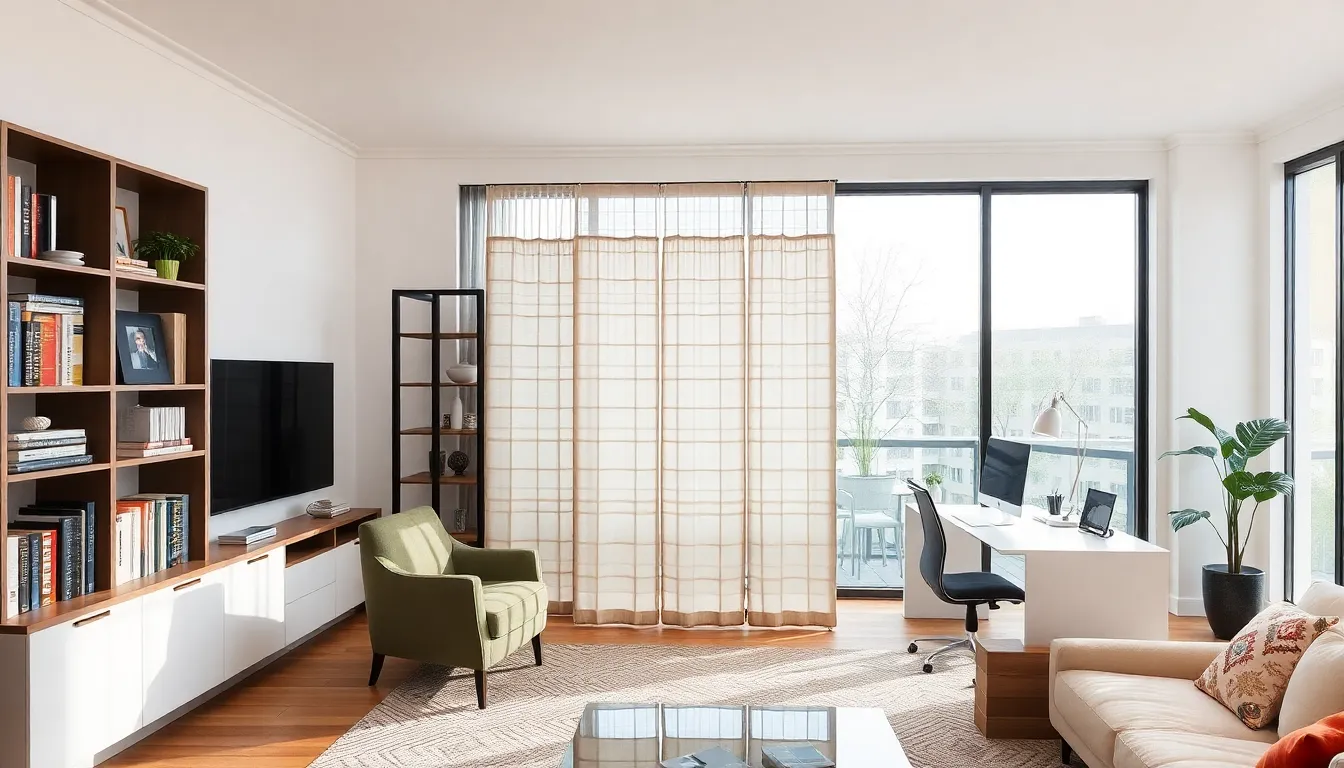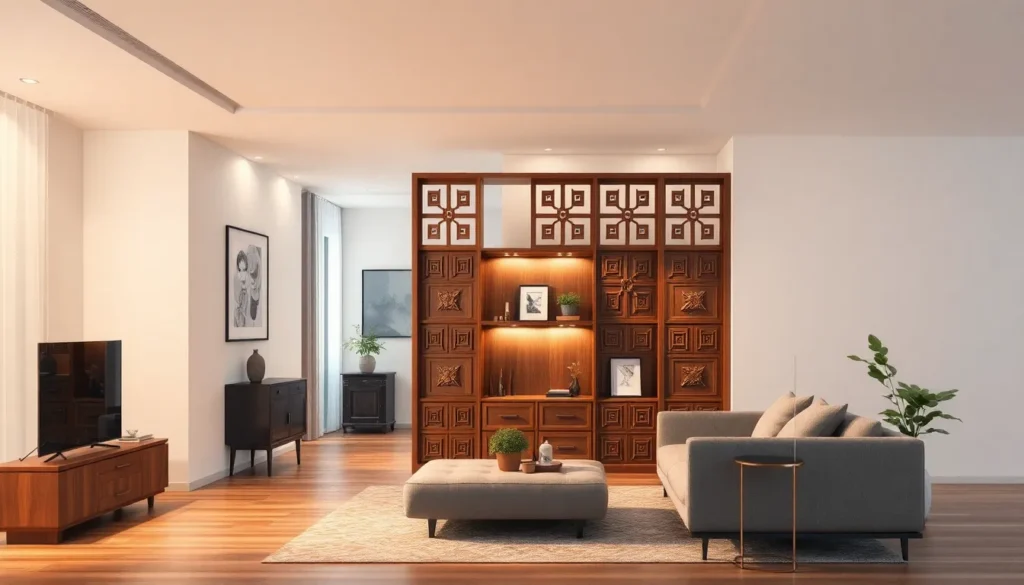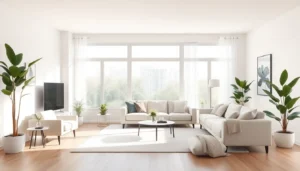In a world where open floor plans reign supreme, room dividers swoop in like superheroes, saving the day with style and function. They’re not just fancy screens; they’re the ultimate multitaskers, transforming a single space into a cozy nook or a private office faster than you can say “home improvement.”
Table of Contents
ToggleOverview of Room Dividers
Room dividers offer a practical solution for creating distinct areas within open spaces. Various styles and materials allow customization to fit diverse design preferences. Whether using screens, curtains, or bookshelves, individuals can easily define spaces for different activities.
Many room dividers serve multiple functions, such as providing storage and displaying decor. Folding screens become popular for temporary separations, adding elegance and flexibility. Additionally, glass panels maintain an open feel while delineating spaces effectively.
In urban environments, where efficient use of space is essential, room dividers enhance functionality significantly. These essential elements cater to the needs of those living in smaller homes or apartments. Incorporators of modern designs often prioritize minimalism, making dividers an integral part of their aesthetic.
Moving from one area to another can create visual interest while promoting privacy. Many homeowners appreciate the ability to change layouts easily without extensive renovations. Sliding doors or retractable curtain systems allow instant reconfiguration of a room.
Moreover, their role in sound absorption adds an extra layer of comfort. Acoustic panels transform spaces into quieter environments, vital for remote work settings. Room dividers not only enhance visual appeal but also improve overall functionality and comfort within a home.
Adapting to lifestyle changes, room dividers can respond swiftly to varying needs. Transitioning from a serene workspace to an intimate gathering spot highlights their versatility. Each divider contributes to the versatility of a home, amplifying its potential and utility.
Types of Room Dividers

Different types of room dividers serve various purposes, offering options for enhancing both aesthetics and functionality in living spaces.
Furniture-Based Dividers
Furniture-based dividers utilize items like bookshelves, cabinets, or sofas to create separate zones within a room. These dividers provide storage and display space while also segmenting areas. Bookshelves, for example, can showcase decor and books, enhancing visual appeal. Sofas not only offer seating but also add style, differentiating functional areas without obstructing light or space. Many people opt for multifunctional furniture to maximize usability, making these dividers ideal for smaller homes.
Portable Dividers
Portable dividers include folding screens and curtain panels that can be easily relocated. Lightweight and versatile, these structures adapt quickly to changing space needs. Folding screens add an element of elegance while providing privacy when necessary, enhancing the room’s atmosphere. Curtains offer flexibility in design and function, allowing for quick adjustments in layouts. Many individuals choose portable options for temporary solutions during gatherings or multi-use spaces, ensuring convenience and adaptability.
Fixed Dividers
Fixed dividers involve more permanent solutions like walls or glass panels. These installations create lasting separations in open floor plans while enhancing sound insulation. Glass panels, for instance, maintain an open feel yet provide defined spaces, perfect for modern designs. Walls can effectively separate workspaces from living areas, boosting focus and productivity. Homeowners often opt for fixed dividers to ensure long-term functionality and aesthetics in their environments, combining practicality with sophisticated design.
Materials Used in Room Dividers
Various materials contribute to the design and functionality of room dividers. Each material offers unique advantages tailored to different needs.
Wood
Wood remains a popular choice for room dividers due to its natural warmth and durability. It can suit various styles, from rustic to modern. Many options exist, such as solid wood panels, reclaimed wood, and veneer finishes. Some prefer customizable wood dividers, allowing them to match existing decor. Wood’s inherent strength offers excellent sound absorption, making spaces quieter. Moreover, it’s easy to incorporate storage solutions, like shelves and cabinets, into wooden dividers. This versatility enhances functionality while adding aesthetic appeal.
Glass
Glass provides a sleek, contemporary option for room dividers. Often used in homes with open floor plans, glass allows light to flow through while providing visual separation. Frosted glass offers privacy without completely blocking light, making it a preferred choice for offices or bedrooms. Many designs include framed glass to enhance stability and style. When considering sound control, laminated glass can effectively reduce noise levels. Its aesthetically pleasing finish complements modern interiors, contributing to an overall airy feel. Homeowners frequently choose glass dividers to maintain an open atmosphere without sacrificing privacy.
Fabric
Fabric dividers offer flexibility and variety in style and function. Soft textiles can create warmth and comfort while acting as sound barriers. Many options exist, including curtains, drapes, and folding screens, allowing for easy adjustments based on needs. Lightweight fabrics make repositioning a breeze, ideal for temporary configurations. Diverse patterns and colors enhance the overall decor, making fabric dividers stylish additions. This material also allows for easy maintenance, as many fabrics are machine washable. Individuals often favor fabric dividers for both separation and decorative flair.
Benefits of Using Room Dividers
Room dividers provide significant flexibility in living spaces. They can transform large areas into cozy corners with minimal effort. Privacy becomes easily attainable without the need for permanent walls.
Enhanced functionality stands out as a key advantage. Furniture-based dividers offer additional storage while serving as aesthetic components. Portable options allow for quick reconfiguration, adapting to changing needs.
Sound absorption is another crucial benefit. These dividers reduce noise levels, enhancing comfort, particularly in work-from-home scenarios. A quieter environment contributes to improved focus during remote work and relaxation.
Visual appeal remains a priority. Various styles and materials allow homeowners to choose options that align with their decor. A wood divider adds warmth, while glass provides a modern, airy feel.
Cost-effectiveness plays a role, too. Compared to renovations, room dividers offer an affordable method to create distinct areas within a home. Homeowners often appreciate this economical approach.
Adaptability characterizes room dividers. They transition seamlessly from workspaces to gathering spots, accommodating different lifestyles. Flexibility in design enhances overall home utility, aligning with individual needs.
Environmental benefits also exist. Sustainable materials, like reclaimed wood, contribute to eco-friendly living. Each choice can reflect an owner’s values while enhancing space functionality.
By using room dividers, individuals maximize the potential of their living spaces. They cater to various needs, demonstrating versatility in modern home design. Adjusting layouts without extensive renovations leads to a creative and efficient use of space.
Tips for Choosing the Right Room Divider
Selecting an appropriate room divider enhances both aesthetics and functionality. Consider the size of the space; larger areas benefit from bigger dividers for more impactful separation. Define the purpose clearly; identify whether the divider will provide privacy, storage, or simply act as a decorative element. Take into account the existing decor; choose a style that complements other furnishings and colors for visual harmony.
Evaluate material options carefully. Wood offers warmth and durability; glass provides a sleek appearance with light flow. Fabric dividers introduce color and texture, serving as sound barriers while allowing flexibility. Assess maintenance needs as well; some materials require more upkeep than others.
Examine the placement flexibility of the divider. Portable options like folding screens allow for easy rearrangement, making them ideal for temporary changes. Fixed dividers, such as glass panels or walls, ensure a permanent solution but limit mobility.
Incorporate multifunctionality when possible. A bookshelf divider not only separates spaces but also enhances storage, serving dual purposes effectively. Sounds absorption features are vital; prioritize dividers designed for soundproofing, especially in shared living environments or workspaces.
Lastly, keep budget considerations in mind. Room dividers present a cost-effective alternative to extensive renovations. Explore various styles and materials within your price range to ensure a balance of quality and affordability. Each choice contributes to creating personalized living spaces that meet both practical and aesthetic desires.
Room dividers are a game-changer in modern home design. They not only enhance functionality but also elevate the aesthetic appeal of any space. With various styles and materials available, homeowners can find the perfect solution to meet their needs.
Whether it’s creating a cozy nook or providing privacy in an open layout, room dividers offer flexibility and versatility. Their ability to adapt to changing lifestyles makes them an invaluable addition to any home.
By carefully selecting the right type and material, individuals can transform their living spaces into personalized sanctuaries that reflect their unique tastes and requirements. Ultimately, room dividers are more than just practical solutions; they’re essential tools for maximizing space and comfort in today’s homes.





